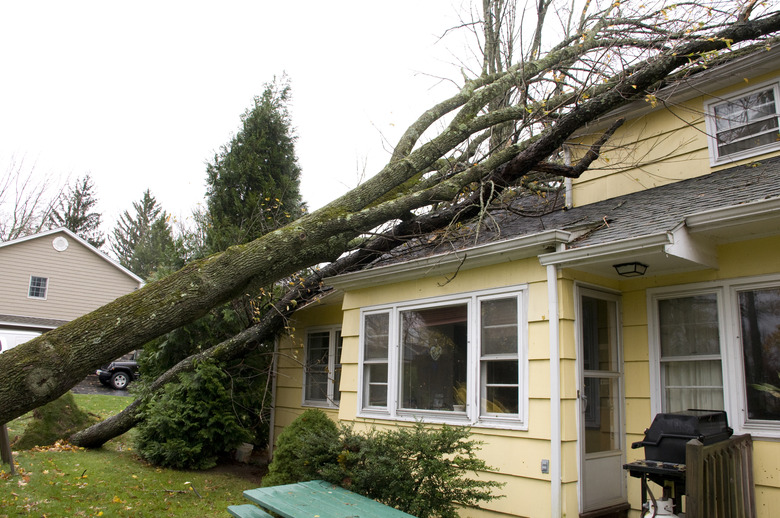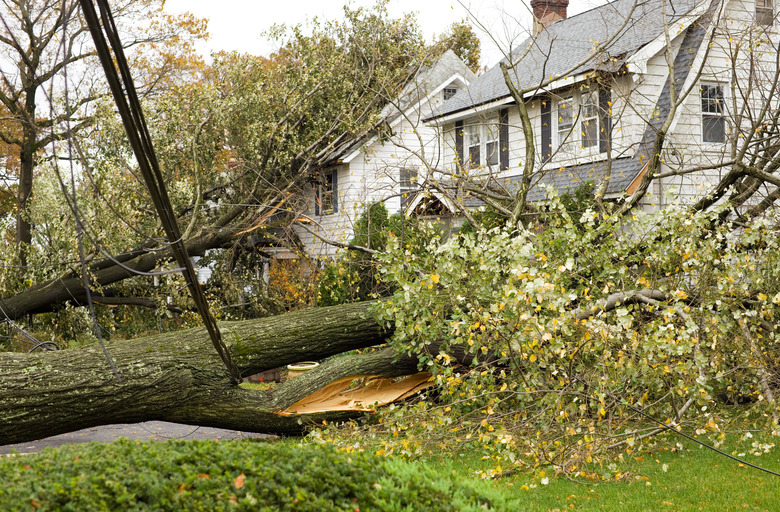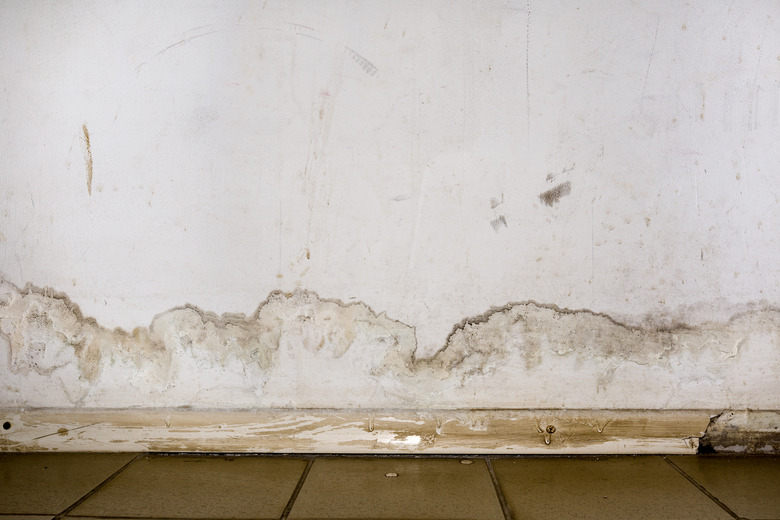How To Clean Up Your House After Hurricane Damage
We may receive a commission on purchases made from links.
A hurricane delivers a one-two punch of destructive winds accompanied by heavy rains — so besides salvaging what you can from a damaged building, post-hurricane cleanup also involves floodwater remediation. Water complicates everything. It creates a hazard by being an electrical conductor, it introduces dangerous pathogens and possibly creepy critters like snakes and rats and once you manage to get rid of it and it leaves toxic mold in its wake. There's no doubting the severity of damage that heavy winds can cause, but there's no natural disaster like a flood.
When you get the all-clear to return to your house after a hurricane, you might find tree branches on the roof, broken windows and other signs of wind damage in the upper part of the building, but at ground level, you'll probably find water — murky standing water that could be concealing broken glass and other hazardous objects. It's important to be prepared for it by having the right protective equipment, and you'll want to proceed with caution. If the storm damaged any part of the home's electrical system, appliances could be compromised, and live wires could be left exposed in the water, and one wrong step could give you a serious or even fatal shock.
Even if the storm spared you the floodwater, a large part of your efforts will go to cleaning water-damaged walls and floors, drying things out and disinfecting, but there will obviously be plenty of other things to do too. Don't try to do it all at once and don't work alone — you'll need a team to do the heavy lifting.
Equipment You'll Need for the Cleanup
Equipment You'll Need for the Cleanup
The post-disaster cleanup protective clothing recommended by the Centers for Disease Control and Prevention (CDC) will make you look like you're heading out into the woods to fell trees or working on a large-scale construction project, but you need all of it. The items recommended by the CDC as well as the American Red Cross are:
- Hard hats for everyone in the cleanup party to protect heads from falling objects
- Waterproof boots with steel toes and, if possible, insoles
- Heavy-duty work gloves
- A high-quality respirator with the filtering capability of an N95 mask
- Goggles with a flexible band that can seal against your face
- Earmuffs or ear plugs if you're working with a chain saw or other noisy equipment
- At least two class A, B and C fire extinguishers
- A first-aid kit to take care of minor injuries
Floodwater usually brings sewage to the surface, so if you're entering any area with standing water, you should be prepared for it by wearing rubber boots and rubber gloves. You're also going to need buckets, sponges, disinfectant and plenty of rags. You'll probably also need power tools, particularly a reciprocating saw, a chain saw and a drill. These should be battery powered so you don't have to plug them in (a chain saw could also be gas powered).
Tip
Don't forget to bring your mobile device or a camera so you can take pictures. It's important to document all the damage for the insurance company. Keep your camera handy so you can document damage before you clean it up.
Proceed Cautiously and Take Pictures
Proceed Cautiously and Take Pictures
When you first return to your home after a hurricane, you have no idea what you'll encounter. There may be downed power lines and gas leaks, and if any conditions are dangerous, you'll probably be alerted by first responders who often conduct preliminary inspections before evacuation orders are lifted. Even if you get the all-clear, hazardous conditions may still exist, so it's important to proceed with caution. Conduct your inspections during the daytime and bring a powerful flashlight to help you see in the basement and in dark hallways. Do not turn on the lights.
Once inside, open all the doors and windows to get air circulating in the building, to minimize water damage and to disperse any gas that may have been released during the event. If it's safe to do so, turn off the main circuit breaker in the electrical panel and shut off the main gas supply valve, but if it isn't safe, you can get an electrician to disconnect power at the meter or have the utility shut off the power service to the house.
Once everything is secure, take detailed pictures of the damage indoors and out, including damage caused by trees, broken windows, water damage on the drywall, floodwater on the floor and damaged carpeting. Take pictures of any damage that occurred to the HVAC system and don't forget to document exterior damage to the home and the property in general. You'll need these pictures when you file your insurance claims.
If your HVAC system has been flooded, don't use it until you have it checked by an HVAC technician. The tech will pressure-test the system to be sure there aren't any leaks that could result in the release of poisonous gases into the home, including carbon monoxide. If the water has been standing long enough to cause corrosion, the tech will recommend the appropriate course of action, and as long as you've documented the damage, your insurance should cover the expense.
Clear Floodwater and Do a Preliminary Cleanup
Clear Floodwater and Do a Preliminary Cleanup
The first part of the flood cleanup job will involve heavy lifting, as you move furniture out of flooded rooms and clear any large debris that you find. Whenever you move any of the home's furnishings outside or clear damaged parts of the home that are in the way, take a picture of the damaged furnishings or the affected areas of the home. Clear a path by cutting long pieces of wood that have fallen from the walls or ceiling into shorter pieces using a chainsaw or reciprocating saw, but be cautious as you get this task done — you may end up creating more damage than what you started with.
Take pictures before you do any demolition, and if you're unsure whether your demolition will result in any hazardous instabilities, hold off on doing it yourself and wait until a professional contractor can do the work. This may mean you have to work around the damage to do floodwater remediation, but it's safer than having part of the house collapse while you're working.
Removing floodwater from a room can be a strenuous job. A quick way to do it is to scoop it up in plastic buckets and carry it outside but keep in mind that a gallon of water weighs over 8 pounds, so work slowly and preferably with helpers. It's a lot easier to scoop up water with a wet/dry vacuum, but if the power is off, you'll need a battery-powered model, which is fortunately easy to find. When you've removed the bulk of the water and an inch or less remains on the floor, you should be able to push it out of the door using a floor squeegee and then sponge the remainder into buckets.
Cleanup Tips for Water-Damaged Areas
Cleanup Tips for Water-Damaged Areas
Whether or not you have to clear standing water, parts of the house are bound to have sustained water damage after a hurricane, and the sooner you can dry things out, the less chance there is of mold growth. Ventilation is key, so make sure the doors and windows stay open, and if you have electricity, run a dehumidifier in any room that has gotten wet, particularly if the outside air is still humid, which is common after a hurricane. Even if the house is well-ventilated, though, you'll have to disinfect to prevent mold from getting established.
Any porous objects or surfaces, including drywall and carpeting, have to be discarded after sustaining water damage, but hard surfaces, such as flooring, table tops and appliance surfaces, can be disinfected with a bleach and water solution. The CDC recommends a disinfectant consisting of a mixture of 1 cup household bleach per gallon of water. Bleach has a high surface tension that prevents it from penetrating porous surfaces, which is why drywall, carpeting, upholstered furniture and similar objects often have to be thrown out after suffering water damage, with the exception of painted drywall that has suffered only minor damage. You can often treat painted drywall that has suffered minor damage as a hard surface and disinfect it with a bleach/water solution.
If you don't like the idea of working with bleach, which requires the use of rubber gloves, it is permissible to clean visible mold with a solution of soap and water, as recommended by the Environmental Protection Agency. The important thing is to physically remove all the mold, and if the mold covers an area larger than 10 square feet, have it professionally removed.
Cleaning Up Fire and Smoke Damage
Cleaning Up Fire and Smoke Damage
Fires can occur during a hurricane when gas pipes rupture, and the gas is ignited by electrical arcing. Damage from a major fire isn't something a homeowner can typically handle without professional help, and some rebuilding is probably in the picture, but documenting the damage with pictures is essential to help move the insurance claims forward. Minor damage, however, such as soot residue from an electrical fire or smoky odors, is something that a homeowner can address during the post-disaster cleanup.
Soot cleanup calls for a strong cleaning agent, such as trisodium phosphate (TSP) (or a TSP substitute in parts of the country where TSP is prohibited). Mix a strong solution consisting of 1/2 to 1 cup TSP per gallon of water (hot water is more effective than cold water) and scrub down affected areas with a sponge or a scrub brush if necessary. TSP is corrosive, so be sure to wear rubber gloves when working with it and avoid touching the soot with your hands or with anything else prior to cleaning it, or you'll just spread it and make it that much harder to remove. Soot can be difficult to remove from fabric, so you may have to discard fabric items, such as soot-damaged pillows, blankets and clothing.
Electrical fixtures and wiring are likely to be compromised in any part of the house that has suffered fire damage. It's important to keep off the breakers that control the power to those parts of the house until the wiring can be inspected by an electrician. This is something for which you really need a professional because all the wires need to be tested for continuity. If there's a break behind a wall and you restore power, you could start another fire.
References
- Sears: 9 Tips for How to Clean Up Your Home After a Hurricane
- Centers for Disease Control and Prevention: Clean Up Safely After a Disaster
- Ready.gov: Hurricanes
- American Family Insurance: How to Clean Up Safely After a Hurricane
- American Red Cross: Disaster Cleanup & Repair For Your Home
- United States Environmental Protection Agency: Mold Cleanup in Your Home


